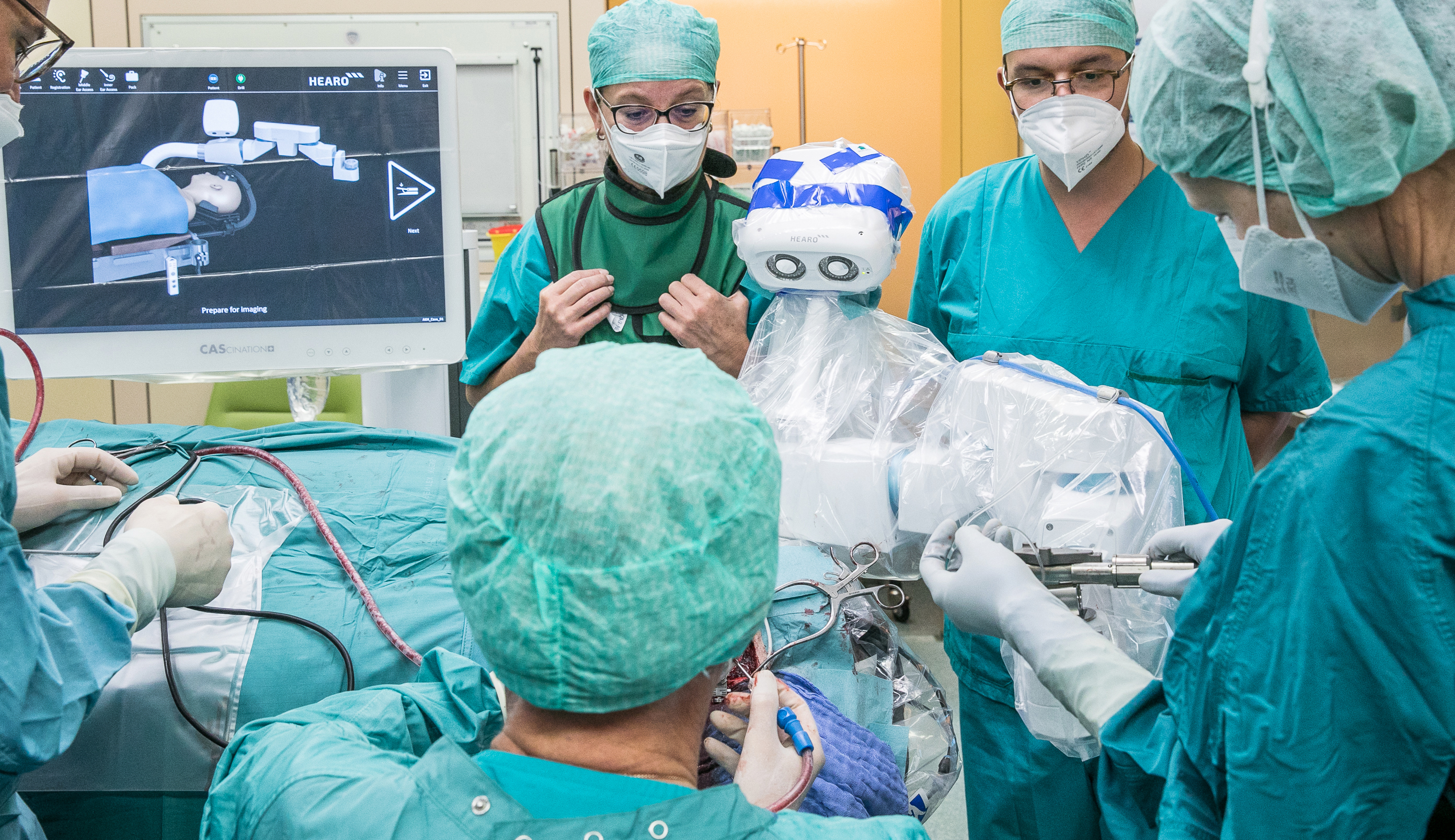
(Vienna, 28 October 2021) One of the world's first operations performed by a new robotic technology has taken place at MedUni Vienna and Vienna General Hospital's Department of Ear, Nose and Throat Diseases. During the minimally invasive cochlear implant operation, the high-tech device automatically used a feed of accurate data to provide precise access to the inner ear. This high degree of automation and highly precise navigation offer a glimpse into the future of robot-assisted surgery.
Robotic surgical procedures have been an integral part of surgery for several years now. Surgical robots act as an extension to the surgeon's arm and translate their movements in a very confined space. In combination with modern imaging techniques, this allows minimally invasive procedures, also known as keyhole surgery, to be performed.
At the Department of Ear, Nose and Throat Diseases, one of the world's first operations has now been successfully performed using a new technology that represents a twofold quantum leap: the new technology works fully automatically without manual control by surgeons and is equipped with a high-precision navigation system with such a small range of variation that surgery in a very confined space, such as cochlear implant surgery, can be performed as a minimally invasive procedure.
Operating on autopilot
"This new technology can be compared to the autopilot system in an aircraft. Like the autopilot, the robot works with a precise navigation system, which is fed with all the necessary information relating to the cochlea into which the cochlear implant is being inserted, and the position of the facial and gustatory nerves. With this new technology, the surgeon no longer controls manually. The robot is started and then works without manual control," explains Wolfgang Gstöttner from the Department of Ear, Nose and Throat Diseases, who led the cochlear implant operation.
However, the high-tech system cannot yet work entirely without specialists. The technology includes a transportable intraoperative CT device. Before the surgical robot starts, this device produces a CT scan, onto which the specialists draw exactly where the cochlea and the surrounding nerves are located using their own software. Based on this data, the high-tech device creates a 3D model and calculates whether the robot can set a suitable angle for accessing the cochlea without hitting arteries or nerves. Only if the result of this calculation is satisfactory, can the robot start with the actual procedure. The surgeon makes the incision behind the ear beforehand, as well as placing four or five screws that the robot needs as fixation points. The implant itself is also placed manually in the cochlea once drilling is completed.
Multi-level safeguards during the operation
The intervention by the surgical robot is subject to multi-level safeguards. The access is drilled in stages and the system checks the angle of the canal between each drilling step. Highly accurate measurements are provided for the location where the drilling passes the facial nerve. The specialists assist at this point and place the electrodes for monitoring the patient. If any value is less than optimal, the robot automatically aborts the drilling process. This cannot then be restarted, even by manual override. The operation would then have to be continued manually.
This was not necessary during the operation performed at the Department of Ear, Nose and Throat Diseases of MedUni Vienna and Vienna General Hospital. The procedure was successfully performed using the high-tech robot as planned.
High-precision navigation system
The new technology represents a quantum leap, especially for high-precision procedures such as cochlear implant surgery. Due to the minute dimensions of the human ear, currently available devices that have navigation systems cannot be used, as they have a range of variation of three to four millimetres. Even this minimal value is too high for cochlear implant surgery, since the cochlea is only 1 millimetre in diameter and the surrounding facial and gustatory nerves are immediately adjacent. Specialist surgeons have to mill a 2 to 3-centimetre-deep cavity in the skull behind the ear over the site of the cochlea to allow the implant to be inserted manually in a complex procedure.
"The new technology offers hope that, in future, even highly precise procedures such as those on the ear can be robotically assisted and thus performed as gently as possible for patients," says Gstöttner.
The "HEARO" robot technology was developed by the Swiss medical technology company CASCINATION and is operated jointly with the Innsbruck-based medical technology company MED-EL. "HEARO" has been approved for clinical use and is expected to be loaned to the Department of Ear, Nose and Throat Diseases until the end of the year.